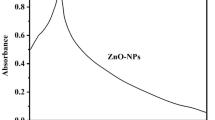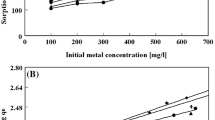Abstract
Sorptive removal is seen as a viable option to remove dissolved ions from an aqueous solution. The study reports the use of leaf extract of Ocimum sanctum L. (Tulsi) for nano-size iron preparation. Prepared particles were entrapment into calcium alginate- κ-carrageenan beads acting as adsorbents for arsenic ions. Further, characterization of iron particles and beads was performed using UV–Vis, TEM, SAED, SEM-EDAX, and FT-IR, respectively. The data obtained from the batch sorption study revealed that iron entrapped calcium alginate-κ-carrageenan beads removal efficiency for arsenite and arsenate ions was 88.25% and 95.75%, respectively at pH 3.0. The maximum adsorption was achieved for 25 min of contact time at adsorbent concentration 2 g L−1. The maximum sorption capacity, qm obtained by Langmuir isotherm was found to be 37.63 mg g−1 for arsenate and 35.49 mg g−1 for arsenite ions, respectively. Thermodynamic studies suggested that the chemisorption process was accountable for the removal of analyte ions. As iron, alginate, and carrageenan are none toxic to human health, thus beads could be seen as a promising candidate material for the removal of dissolved arsenic ions from an aqueous solution.
Graphical abstract







Similar content being viewed by others
References
Vörösmarty CJ, McIntyre PB, Gessner MO et al (2010) Global threats to human water security and river biodiversity. Nature 467:555–561. https://doi.org/10.1038/nature09440
Mandal B, Chowdhury T, Samanta G et al (1998) Impact of safe water for drinking and cooking on five arsenic-affected families for 2 years in West Bengal, India. Sci Total Environ 218:185–201. https://doi.org/10.1016/S0048-9697(98)00220-4
Singh R, Singh S, Parihar P et al (2015) Arsenic contamination, consequences and remediation techniques: a review. Ecotoxicol Environ Saf 112:247–270. https://doi.org/10.1016/j.ecoenv.2014.10.009
Prasad KS, Srivastava P, Subramanian V, Paul J (2011) Biosorption of As(III) ion on Rhodococcus sp. WB-12: biomass characterization and kinetic studies. Sep Sci Technol 46:2517–2525. https://doi.org/10.1080/01496395.2011.597040
Nickson R, McArthur J, Burgess W et al (1998) Arsenic poisoning of Bangladesh groundwater. Nature 395:338–338. https://doi.org/10.1038/26387
Lakshmanraj L, Gurusamy A, Gobinath MB, Chandramohan R (2009) Studies on the biosorption of hexavalent chromium from aqueous solutions by using boiled mucilaginous seeds of Ocimum americanum. J Hazard Mater 169:1141–1145. https://doi.org/10.1016/j.jhazmat.2009.03.022
Imgharn A, ighnih H, Hsini A, et al (2021) Synthesis and characterization of polyaniline-based biocomposites and their application for effective removal of Orange G dye using adsorption in dynamic regime. Chem Phys Lett 778:138811. https://doi.org/10.1016/J.CPLETT.2021.138811
Imgharn A, Anchoum L, Hsini A et al (2022) Effectiveness of a novel polyaniline@Fe-ZSM-5 hybrid composite for Orange G dye removal from aqueous media: experimental study and advanced statistical physics insights. Chemosphere 295:133786. https://doi.org/10.1016/J.CHEMOSPHERE.2022.133786
Laabd M, Imgharn A, Hsini A et al (2022) Efficient detoxification of Cr(VI)-containing effluents by sequential adsorption and reduction using a novel cysteine-doped PANi@faujasite composite: experimental study supported by advanced statistical physics prediction. J Hazard Mater 422:126857. https://doi.org/10.1016/J.JHAZMAT.2021.126857
Brini L, H’Maida K, Imgharn A et al (2021) Synthesis and characterisation of PANI- coated heliotrope leaves (PANI@HL) with high clean-up capacity for Orange G dye from aqueous media. Int J Environ Anal Chem. https://doi.org/10.1080/0306731920211994557
Hsini A, Naciri Y, Bouziani A et al (2021) Polyaniline coated tungsten trioxide as an effective adsorbent for the removal of orange G dye from aqueous media. RSC Adv 11:31272–31283. https://doi.org/10.1039/D1RA04135E
Amjlef A, Khrach S, Ait El Fakir A et al (2021) (2021) Adsorptive properties investigation of natural sand as adsorbent for methylene blue removal from contaminated water. Nanotechnol Environ Eng 6(2):1–15. https://doi.org/10.1007/S41204-021-00119-Y
Bendell-Young L, Harvey HH (1992) The relative importance of manganese and iron oxides and organic matter in the sorption of trace metals by surficial lake sediments. Geochim Cosmochim Acta 56:1175–1186
Cundy AB, Hopkinson L (2005) Electrokinetic iron pan generation in unconsolidated sediments: implications for contaminated land remediation and soil engineering. Appl Geochem 20:841–848
Li X, Elliott DW, Zhang W (2006) Zero-valent iron nanoparticles for abatement of environmental pollutants: materials and engineering aspects. Crit Rev Solid State Mater Sci 31:111–122. https://doi.org/10.1080/10408430601057611
Song H, Carraway ER (2005) Reduction of chlorinated ethanes by nanosized zero-valent iron: kinetics, pathways, and effects of reaction conditions. Environ Sci Technol 39:6237–6245. https://doi.org/10.1021/es048262e
Kim J-H, Tratnyek PG, Chang Y-S (2008) Rapid dechlorination of polychlorinated dibenzo-p-dioxins by bimetallic and nanosized zerovalent iron. Environ Sci Technol 42:4106–4112
Raveendran P, Fu J, Wallen SL (2003) Completely “green” synthesis and stabilization of metal nanoparticles. J Am Chem Soc 125:13940–13941. https://doi.org/10.1021/ja029267j
Allabaksh MB, Mandal BK, Kesarla MK et al (2010) Preparation of stable zero valent iron nanoparticles using different chelating agents. J Chem Pharm Res 2:67–74
Saleh N, Kim H-J, Phenrat T et al (2008) Ionic strength and composition affect the mobility of surface-modified Fe0 nanoparticles in water-saturated sand columns. Environ Sci Technol 42:3349–3355
Nadagouda MN, Castle AB, Murdock RC et al (2010) In vitro biocompatibility of nanoscale zerovalent iron particles (NZVI) synthesized using tea polyphenols. Green Chem 12:114. https://doi.org/10.1039/b921203p
Mohan D, Pittman CU (2006) Activated carbons and low cost adsorbents for remediation of tri- and hexavalent chromium from water. J Hazard Mater 137:762–811
Ghimire KN, Inoue K, Makino K, Miyajima T (2002) Adsorptive removal of arsenic using orange juice residue. Sep Sci Technol 37:2785–2799. https://doi.org/10.1081/SS-120005466
Balaji T, Yokoyama T, Matsunaga H (2005) Adsorption and removal of As(V) and As(III) using Zr-loaded lysine diacetic acid chelating resin. Chemosphere 59:1169–1174. https://doi.org/10.1016/j.chemosphere.2004.12.007
Katsoyiannis IA, Zouboulis AI (2002) Removal of arsenic from contaminated water sources by sorption onto iron-oxide-coated polymeric materials. Water Res 36:5141–5155
Katsoyiannis I, a., Zikoudi A, Hug SJ, (2008) Arsenic removal from groundwaters containing iron, ammonium, manganese and phosphate: a case study from a treatment unit in northern Greece. Desalination 224:330–339. https://doi.org/10.1016/j.desal.2007.06.014
Baig JA, Kazi TG, Shah AQ et al (2010) Biosorption studies on powder of stem of Acacia nilotica: removal of arsenic from surface water. J Hazard Mater 178:941–948. https://doi.org/10.1016/j.jhazmat.2010.02.028
Prasad B, Dave H, Maurya DM et al (2021) Sorptive removal of aqueous arsenite and arsenate ions onto a low cost, calcium modified Moringa oleifera wood biochar (CaMBC). Environ Qual Manag. https://doi.org/10.1002/TQEM.21831
Mohan D, Pittman CU, Bricka M et al (2007) Sorption of arsenic, cadmium, and lead by chars produced from fast pyrolysis of wood and bark during bio-oil production. J Colloid Interface Sci 310:57–73. https://doi.org/10.1016/j.jcis.2007.01.020
Han Y-S, Gallegos TJ, Demond AH, Hayes KF (2011) FeS-coated sand for removal of arsenic(III) under anaerobic conditions in permeable reactive barriers. Water Res 45:593–604. https://doi.org/10.1016/j.watres.2010.09.033
Srivastava A, Dave H, Prasad B et al (2022) Adsorptive behavior of l-arginine-silica micro-particles against arsenic and fluoride in aqueous solution. Environ Nanotechnol Monit Manag 17:100636. https://doi.org/10.1016/J.ENMM.2021.100636
Yu F, Yang P, Yang Z et al (2021) Double-network hydrogel adsorbents for environmental applications. Chem Eng J 426:131900. https://doi.org/10.1016/J.CEJ.2021.131900
Yu F, Yang Z, Zhang X et al (2021) Lanthanum modification κ-carrageenan/sodium alginate dual-network aerogels for efficient adsorption of ciprofloxacin hydrochloride. Environ Technol Innov 24:102052. https://doi.org/10.1016/J.ETI.2021.102052
Sharma S, Sharma G, Kumar A et al (2022) Adsorption of cationic dyes onto carrageenan and itaconic acid-based superabsorbent hydrogel: Synthesis, characterization and isotherm analysis. J Hazard Mater 421:126729. https://doi.org/10.1016/J.JHAZMAT.2021.126729
Duman O, Polat TG, Diker CÖ, Tunç S (2020) Agar/κ-carrageenan composite hydrogel adsorbent for the removal of methylene blue from water. Int J Biol Macromol 160:823–835. https://doi.org/10.1016/J.IJBIOMAC.2020.05.191
Alshahrani A, Alharbi A, Alnasser S et al (2021) Enhanced heavy metals removal by a novel carbon nanotubes buckypaper membrane containing a mixture of two biopolymers: chitosan and i-carrageenan. Sep Purif Technol 276:119300. https://doi.org/10.1016/J.SEPPUR.2021.119300
Liu C, Omer AM, Ouyang X, kun, (2018) Adsorptive removal of cationic methylene blue dye using carboxymethyl cellulose/k-carrageenan/activated montmorillonite composite beads: isotherm and kinetic studies. Int J Biol Macromol 106:823–833. https://doi.org/10.1016/J.IJBIOMAC.2017.08.084
Prasad KS, Gandhi P, Selvaraj K (2014) Synthesis of green nano iron particles (GnIP) and their application in adsorptive removal of As(III) and As(V) from aqueous solution. Appl Surf Sci. https://doi.org/10.1016/j.apsusc.2014.09.042
Srivastava A, Kumari M, Prasad KS (2021) Hydrogel beads containing ginger extract mediated nano-zirconium as an adsorbent for fluoride removal from aqueous solution. Int J Environ Anal Chem. https://doi.org/10.1080/03067319.2021.1877282
Banerjee S, Chattopadhyaya MC (2017) Adsorption characteristics for the removal of a toxic dye, tartrazine from aqueous solutions by a low cost agricultural by-product. Arab J Chem 10:S1629–S1638. https://doi.org/10.1016/J.ARABJC.2013.06.005
Bakatula EN, Richard D, Neculita CM (2018) Zagury GJ (2018) Determination of point of zero charge of natural organic materials. Environ Sci Pollut Res 258(25):7823–7833. https://doi.org/10.1007/S11356-017-1115-7
Morgada ME, Levy IK, Salomone V et al (2009) Arsenic(V) removal with nanoparticulate zerovalent iron: effect of UV light and humic acids. Catal Today 143:261–268. https://doi.org/10.1016/j.cattod.2008.09.038
Awwad AM, Salem NM (2012) A green and facile approach for synthesis of magnetite nanoparticles. Nanosci Nanotechnol 6:208–213
Klačanová K, Fodran P, Šimon P et al (2013) Formation of Fe(0)-nanoparticles via reduction of Fe(II) compounds by amino acids and their subsequent oxidation to iron oxides. J Chem 2013:10
Nurmi JT, Tratnyek PG, Sarathy V et al (2005) Characterization and properties of metallic iron nanoparticles: spectroscopy, electrochemistry, and kinetics. Environ Sci Technol 39:1221–1230. https://doi.org/10.1021/es049190u
Senthilkumar R, Prasad DMR, Govindarajan L et al (2019) Synthesis of green marine algal-based biochar for remediation of arsenic(V) from contaminated waters in batch and column mode of operation. Int J Phytoremed 22:279–286. https://doi.org/10.1080/15226514.2019.1658710
Lin L, Song Z, Huang Y et al (2019) (2019) Removal and oxidation of arsenic from aqueous solution by biochar impregnated with Fe-Mn oxides. Water Air Soil Pollut 2305(230):1–13. https://doi.org/10.1007/S11270-019-4146-5
Prasad KS, Ramanathan AL, Paul J et al (2013) Biosorption of arsenite (As+3) and arsenate (As+5) from aqueous solution by Arthrobacter sp. biomass. Environ Technol 34:2701–2708. https://doi.org/10.1080/09593330.2013.786137
Tuzen M, Sari A, Mendil D et al (2009) Characterization of biosorption process of As(III) on green algae Ulothrix cylindricum. J Hazard Mater 165:566–572. https://doi.org/10.1016/j.jhazmat.2008.10.020
Sarı A, Tuzen M (2010) Biosorption of As(III) and As(V) from aqueous solution by lichen (Xanthoria parietina) biomass. Sep Sci Technol 45:463–471. https://doi.org/10.1080/01496390903526642
Alchouron J, Navarathna C, Rodrigo PM et al (2021) Household arsenic contaminated water treatment employing iron oxide/bamboo biochar composite: an approach to technology transfer. J Colloid Interface Sci 587:767–779. https://doi.org/10.1016/J.JCIS.2020.11.036
Hu X, Ding Z, Zimmerman AR et al (2015) Batch and column sorption of arsenic onto iron-impregnated biochar synthesized through hydrolysis. Water Res 68:206–216. https://doi.org/10.1016/J.WATRES.2014.10.009
Acknowledgements
SERB, New Delhi Grant, SR/FTP-120/ES/2014 was instrumental in achieving the many goals of this study.
Author information
Authors and Affiliations
Contributions
AS, SKA, KS, (Ph.D.) students performed experiments and wrote the manuscript. BP, (Assistant Professor) MK, (Research assistant) Nandan (Research scientist), AKS, HD, DMM and DS arranged logistics and helped in the analysis of the sample, while KSP acted as a mentor and interpreted the results of the analysis.
Corresponding author
Ethics declarations
Conflict of interest
The authors declare no conflict of interest.
Additional information
Publisher's Note
Springer Nature remains neutral with regard to jurisdictional claims in published maps and institutional affiliations.
Rights and permissions
Springer Nature or its licensor holds exclusive rights to this article under a publishing agreement with the author(s) or other rightsholder(s); author self-archiving of the accepted manuscript version of this article is solely governed by the terms of such publishing agreement and applicable law.
About this article
Cite this article
Srivastava, A., Azad, S.K., Singh, K. et al. Arsenite and arsenate ions adsorption onto a biogenic nano-iron entrapped dual network Fe@alginate-κ-carrageenan hydrogel beads. Nanotechnol. Environ. Eng. 8, 269–279 (2023). https://doi.org/10.1007/s41204-022-00280-y
Received:
Accepted:
Published:
Issue Date:
DOI: https://doi.org/10.1007/s41204-022-00280-y




